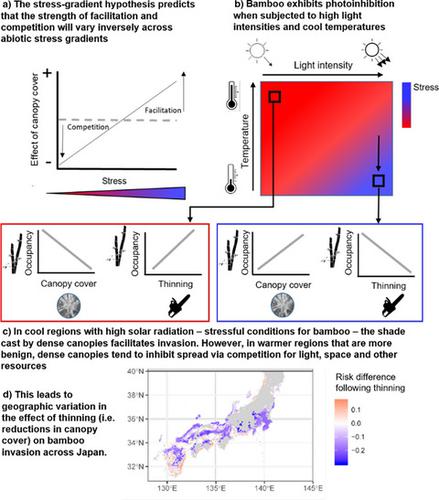当前位置:
X-MOL 学术
›
J. Appl. Ecol.
›
论文详情
Our official English website, www.x-mol.net, welcomes your
feedback! (Note: you will need to create a separate account there.)
Applying the stress-gradient hypothesis to curb the spread of invasive bamboo
Journal of Applied Ecology ( IF 5.0 ) Pub Date : 2021-06-10 , DOI: 10.1111/1365-2664.13945 Rebecca Spake 1 , Masashi Soga 2 , Jane A. Catford 3 , Felix Eigenbrod 1
中文翻译:

应用应力梯度假说遏制入侵竹子的传播
更新日期:2021-06-10
Journal of Applied Ecology ( IF 5.0 ) Pub Date : 2021-06-10 , DOI: 10.1111/1365-2664.13945 Rebecca Spake 1 , Masashi Soga 2 , Jane A. Catford 3 , Felix Eigenbrod 1
Affiliation

|
- The stress-gradient hypothesis (SGH) provides a conceptual framework for explaining how environmental context determines the nature of biotic interactions. It may be also useful for predicting geographic variability in the effect of management interventions on biological invasions. We aimed to test hypotheses consistent with the SGH to explain context dependency in bamboo invasion of secondary forests in Japan, and establish a predictive understanding of forest management impacts on invasion.
- We use a priori physiological knowledge of invasive giant bamboo, Phyllostachys bambusoides, to generate hypotheses consistent with the SGH. We modelled variation in giant bamboo occupancy within 810 secondary forest plots across the broad environmental gradients of Japan using a national vegetation database.
- Consistent with the SGH, we find that the effect of tree canopy cover on bamboo occupancy depends on interactions between solar radiation and mean annual temperature. In cool regions with high solar radiation—stressful conditions for bamboo—shade cast by dense canopies facilitates invasion. However, in warmer regions that are more benign, dense canopies tend to inhibit spread via competition for light, space and other resources.
- Synthesis and applications. We provide evidence that the stress-gradient hypothesis can inform practical recommendations for invasive species control. We characterised geographic variability in the effect of forest thinning, a widespread management intervention used to enhance forest biodiversity, on the risk of bamboo spread into secondary forests in Japan. Thinning forest canopies to increase understorey light radiation should limit bamboo spread in cooler regions, while tree planting to increase canopy shade should limit bamboo spread in warmer regions.
中文翻译:

应用应力梯度假说遏制入侵竹子的传播
- 压力梯度假设 (SGH) 提供了一个概念框架,用于解释环境背景如何决定生物相互作用的性质。它也可用于预测管理干预对生物入侵影响的地理变异性。我们旨在检验与 SGH 一致的假设,以解释日本次生林竹入侵的背景依赖性,并建立对森林管理对入侵影响的预测性理解。
- 我们使用侵入性巨型竹子Phyllostachys bambusoides的先验生理知识来生成与 SGH 一致的假设。我们使用国家植被数据库模拟了日本广泛环境梯度中 810 个次生林地块内巨型竹子占有率的变化。
- 与 SGH 一致,我们发现树冠覆盖对竹子占有率的影响取决于太阳辐射和年平均温度之间的相互作用。在太阳辐射高的凉爽地区——竹子的压力条件——密集的树冠投下的阴影促进了入侵。然而,在更温和的温暖地区,密集的树冠往往会通过对光、空间和其他资源的竞争来抑制传播。
- 合成与应用。我们提供的证据表明,压力梯度假设可以为入侵物种控制提供实用建议。我们描述了森林间伐(一种用于增强森林生物多样性的广泛管理干预措施)对竹子扩散到日本次生林风险的影响的地理变异性。疏伐森林树冠以增加下层光辐射应限制竹子在较冷地区的传播,而植树以增加树冠遮荫应限制竹子在温暖地区的传播。











































 京公网安备 11010802027423号
京公网安备 11010802027423号